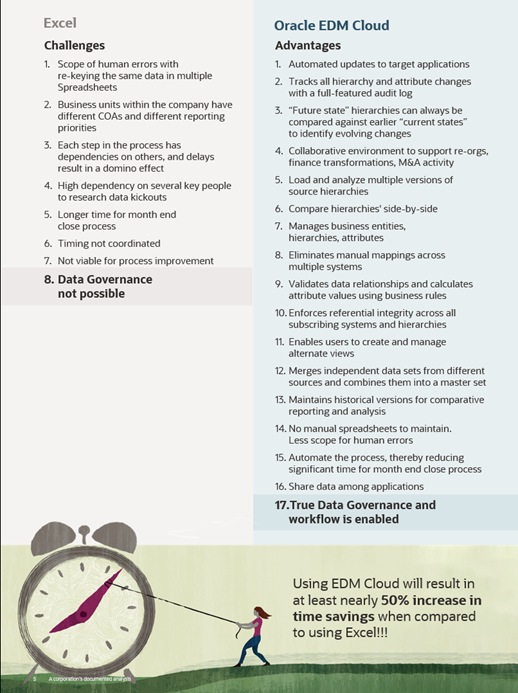Back when the pandemic first hit, every business had to move at top speed to adjust. Now, several years later, you’d expect that the pace of change might start to slow down. It hasn’t. If anything, businesses are showing resilience and moving faster than ever.
Companies need to respond and evolve rapidly to adapt and thrive or be left behind. Many are on the hunt for innovative technologies that can help them succeed with their digital, financial, and business transformations. Modern cloud applications are a critical part of any digital strategy, but consistent enterprise data is key to supporting these transformational initiatives. For those who have taken transformational steps, it’s critical to invest in an on-going governance program to align changes as they occur at the edges of the enterprise with the core enterprise data sets they must keep evergreen.
Traditionally, companies have used spreadsheets, home grown tools, departmental wikis, workflow engines, and bespoke systems to manage the data challenges that come with routine structural change. These DIY processes typically involve meetings, back-and-forth emails, manual recordings, and manual data uploads.
DIY tools and processes became woefully inadequate when the pandemic hit. Prior to the world of remote working, most data management decisions were made during face-to-face meetings, involving a few key individuals who did the consolidated data entry—creating a single point of failure.
In an agile, cloud-enabled enterprise, DIY master data management doesn’t cut it. It’s cumbersome, difficult to maintain, and often understood by only a small number of people in the organization—all of which introduces risk.
Some organizations are tempted to go the in-house route, thinking it offers them more control and better integration capabilities—but they often fail to consider the realities. They must not only deliver a minimum viable product, but also improve and nurture it over time. As you expand usage, and scale the number of changes governed within, the brittle nature of change processes come to the fore. And as data grows, and more applications and domains are feathered in, data management complexity increase. This becomes burdensome to scale in-house. The costs and overheads of enhancing, scaling, upgrading, maintaining, and backing up such a solution snowball into a bottomless money pit. Before you know it, your beloved solution has become a white elephant.
There is a better way. To manage and maintain consistent data, today’s companies need a fully digital, flexible, agile, and incremental platform and service that lets teams work together to manage and govern structural changes from Day 1.
The superiority of a purpose-built cloud EDM
Instead of relying on DIY solutions, companies should look at a purpose-built, off-the-shelf EDM solution like Oracle Enterprise Data Management. Among the reasons to consider Oracle EDM:
Purpose-built
Oracle EDM is tailor-made to solve problems around enterprise data change management. For example, a complex enterprise with many legal entities, operational and analytical requirements, needs an agile platform like EDM. The alternative is to build data management solutions using technologies that weren’t engineered to work together.
Connected and integrated
Out-of-the-box, Oracle EDM offers packaged application adaptors to synchronize with a number of Oracle Cloud applications including Oracle Cloud ERP and Oracle Cloud EPM. Oracle EDM also provides an open interface that lets you integrate with any system—operational or analytical, Oracle or non-Oracle. Newly introduced templates let implementation partners use accelerators that help you expand scope to include third-party applications such as SAP, Workday, Salesforce, etc. All these capabilities come at no additional cost to EDM customers. In a DIY scenario, every one of these capabilities would have to be coded by the customer and maintained over time through engineering change orders—requiring continuous caring and feeding and additional costs to the company.
Self-service and citizen-led
With Oracle EDM, the business can truly take control of its own destiny by unlocking themselves from an IT-led, trouble-ticketing culture to embracing a self-service approach led by “data citizens.” Business users—including application owners and data managers—can configure policies, permissions, and business rules, so that EDM’s context-aware inference engine can invite participants to human workflows and automatically harmonize data across applications. In the spirit of self-service, even the most complex configurations are designed to be accessible to the business, not IT. As an example, business users can use a visual designer to express business logic and translate their requirements into calculated values, filters, predicates and data transformations. If you can express it in logical terms, you can transform data without coding skills.
Rapid innovation
Oracle EDM is a mature solution. It has been generally available as a SaaS service since 2018, and in that time, Oracle has delivered more than 38 new feature releases, rolling out new capabilities to our customers at a rapid cadence. Oracle EDM has changed the game by steering its patented innovations to apply agile methodologies to evolve data transformation initiatives incrementally, add business rules atomically (one at a time without disrupting other rules), and adapt workflows to match changing data policies and standards. Since its introduction, Oracle EDM has evolved from enabling the office of the CFO with a chart of accounts master and an analytical metadata master to delivering a multi-domain enterprise data mastering solution for parties, products, projects and more. Oracle EDM now includes a built-in matching engine that allows one to route requests containing potential duplicates to a data steward to match, merge and blend an incoming item into the target master.
55 percent more efficient
The story of a large retail company illustrates the difference between build vs. buy options. The company had three enterprise resource planning (ERP) systems. As a result, any change to the company’s chart of accounts had to propagate through these three ERPs, planning, financial consolidation and close, and other systems. It took the retailer at least four people and almost five hours to make a single master data change.
The retailer knew it needed a more streamlined, automated system, so they chose Oracle Cloud EDM. Now, change management requires one person and a little over two hours, according to the company’s own time and motion study. Think about the resource reallocation they gained, considering the frequency with which enterprise data needs to be managed for routine changes (not to mention major events, like a merger or a new ERP system).
The retailer’s study found Oracle EDM to be 55 percent more efficient than their internal end-to-end process. In the near term, the company eliminated licenses for multiple on-premises applications, standardized on one chart of accounts, and is working toward its goal of automating the financial close. It also has a seamless enterprise data management process used by all locations in different geographic regions.
The most meaningful difference is that cloud-delivered EDM positions the company to optimize its data resources (people, knowledge, and technology), freeing up application administrators and others for more valuable work. They can put more focus on innovation and improving their competitive advantage, instead of manual data management.
The table below goes further by discussing the advantages of using Oracle EDM over common DIY alternatives such as MS Excel that are the mainstay of legacy approaches to change management.

Image: Excel vs Oracle EDM Cloud
In build vs. buy, “Buy” is the clear winner
The benefits of a cloud EDM solution go beyond efficiency. A purpose-built EDM system can lower your IT costs, improve data governance, reduce the risk associated with bad data, and free up your teams for more value-added work. Building a bespoke technology is a lot like building and flying an airplane just for yourself. You are the only one on the planet flying that airplane! Who would ever build an airplane just for themselves? It’s a bad idea. Our commitment is to build software that is of the highest quality, at the lowest cost, with the fewest errors and omissions, at the lowest risk.
